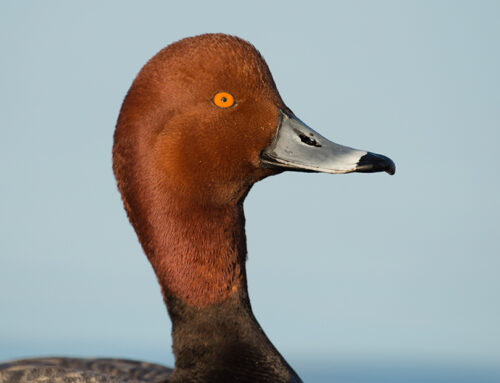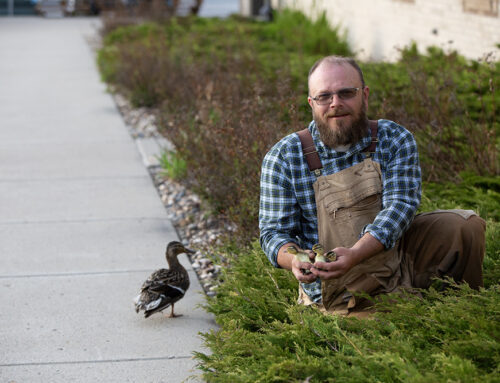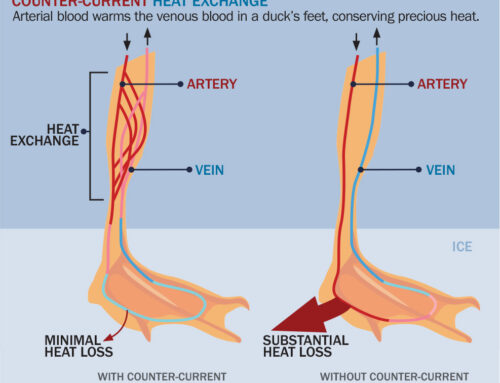Giving Ducks a Fighting Chance
New trapping technique revolutionizing Delta’s Predator Management

It seems a simple concept, at least on the surface: Fewer predators roaming the nesting grounds while feasting on eggs, ducklings and hens ought to mean more mallards, pintails and teal. Delta Waterfowl’s Predator Management program, however, takes a decidedly more targeted, science-based approach to duck production.
“Our work is a lot more complicated than just removing raccoons and skunks, and assuming we helped make some ducks,” said Mike Buxton, who guides Delta’s Predator Management efforts as the organization’s waterfowl programs manager. “Decades of research guide our unique trapping techniques while also telling us which landscapes to select for the biggest possible impact.”
Delta began exploring the concept of Predator Management in 1994, despite the fact many in the scientific community, including within Delta Waterfowl, considered it a fool’s exercise. Since then, the science has proven crystal clear in several regards: The ducks produced per dollar by Predator Management rivals and often exceeds investments in habitat; the program is best deployed in areas with extremely high nesting-duck densities and a lack of adequate grass to hide nests from predators; and trapping especially benefits upland-nesting species, primarily dabblers.
These findings have led Delta to transition many sites in North Dakota from the research phase to “operational” — that is, we know Predator Management works, so let’s invest all resources into making ducks. However, while Predator Management is a proven, effective tool, that doesn’t mean Delta’s innovative biologists aren’t striving to further enhance its efficiency.
A new technique, known as “hotspot trapping,” focuses efforts on isolated patches of nesting cover within areas containing high numbers of breeding ducks, rather than trapping the entire, traditional township-sized block — an area comprising approximately 23,000 acres.
“We started experimenting with ‘hotspot’ trapping in 2015, and it’s looking like the wave of the future,” Buxton said. “It has the potential to broaden our ability to trap across the prairie pothole region, make as many or more ducks as our traditional trapping methods and use our valued Delta members’ dollars even more effectively. In recent years, we’ve documented increased hatch rates of two-, three- and even four-fold over areas without Predator Management.”
Hotspot Hunch
Delta Waterfowl had successfully conducted township-block-style Predator Management for nearly two decades when a pair of Delta biologists sought an improvement. Buxton, along with Matt Chouinard, now Delta’s senior waterfowl programs manager, made a key observation: There was a particular portion of the township block in which Predator Management seemed to be having a disproportionate impact.
“The strategy with township trapping is essentially to set up a perimeter and remove as many predators within it as possible,” Buxton said. “We devoted a lot of resources to trapping roadside ditches, because in areas of high nest densities and heavy agriculture — those ideal for Predator Management — a lot of the grass is in the ditch. But when we pored over the numbers, trapping the ditches made ducks, but that wasn’t where we were having the largest impact.”
Instead, far more ducks were being made per hour and per dollar invested in the highest quality grass within the township landscape — which Buxton’s research found also contained a vast majority of the active nests (up to 85 percent). It stood to reason, Chouinard thought, to see if a targeted approach to trapping such areas could be equally effective.
While Chouinard is credited with the idea, it was Buxton who laid the groundwork for its application.
“If you look at a township trap block, you’ve got a massive area, but in our target landscapes 10 percent or less constitutes good nesting grass,” Buxton said. “That’s approximately 2,300 acres of grass spread across 23,000 acres. So the question was whether trapping cropland, tree rows and culverts was necessary to protect nests in the grass, or if we could save time and money per duck by focusing on the best-available fields for nesting. Maybe a single shot from a rifle would be more effective than a broad shotgun blast. So far it looks like our hunch was correct.”
Proficient Production
The Duck Hunters Organization is committed to maximizing the efficiency of Predator Management, both in terms of making as many ducks as possible and using supporters’ contributions responsibly. Hotspot trapping shows promise in each regard.
“What most excites me about the hotspot technique is we can now take advantage of part-time professional trappers — people who are great at removing predators, but have a day job — and they can manage the area in the mornings and evenings,” Buxton said. “We’re saving money, opening the roster to new trappers and increasing nest success at least as much as with traditional trapping.”
To best picture the concept, imagine you were to take flight in a chartered plane over the breeding grounds with Buxton — his annual fall pilgrimage in search of the choicest candidates for Predator Management. You’d be looking for areas of intensive agriculture and sparse nesting habitat that by spring will still contain a whopping 80 nests per square mile. That’s the perfect potion for Predator Management to make a difference — an area with lots of ducks, but where predators have an egregiously unfair advantage.
“We have biological requirements before we invest resources in Predator Management,” Buxton said. “There are areas of township-size trap blocks I fly over where the estimated number of nesting duck pairs will abruptly drop from 80 to as few as 20 based on habitat and physiology. But then there’s these long, skinny lines of wetlands and grass that are so obvious from the sky, and we know those are the nesting-dabbler hotspots. That’s where we can really make ducks. Hence the term ‘hotspot trapping.’”
Buxton and Joel Brice, Delta’s chief conservation officer, proposed this targeted approach toward predator removal to their team of trappers. The concept was embraced immediately. Trappers noted the flexibility such a system would allow, including the ability to circumvent such trapping hazards as farmers with dogs, livestock and, in rare cases, an aversion to trapping.
“For whatever reason, some landowners in the prairie pothole region really dislike the idea of wildlife management, but they’re surrounded by a huge complex of scattered Waterfowl Production Areas,” Buxton said. “We can now exclude areas where we lack permission and focus trapping on production areas and the lands of favorable landowners in a hotspot fashion. Making ducks used to be impossible in certain township blocks, because if you don’t trap at least 80 percent of the area, you essentially create predator refuges and your effort becomes less effective at making ducks.”
Given hotspot trapping’s high level of efficiency, Buxton’s mathematical modeling calculates that a full-time trapper covering four hotspot sites increases the hatch rate and benefits the same number of paired ducks as a full-time trapper working within a township block.
A Sizeable Advantage
Another reason the hotspot concept resonated with Delta’s professional trappers was its potential to reduce the daunting scope of the areas for which each is responsible. Buxton quickly picked up on the sentiment.
“I asked them to provide a realistic estimate of just how much grass an experienced trapper could cover while achieving noticeable results in terms of improved duck production,” he said. “It was a little awkward, because these folks have as much passion for and pride invested in trapping as we do for duck hunting.”
Ultimately the consensus was that 3,200 targeted acres is a realistic territory for a seasoned trapper to cover. Buxton then accounted for part-time trappers by dividing this number by four.
“Trapping contracts comprising 800 acres seem like the sweet spot,” Buxton said. “Experienced, full-time Delta trappers can take multiple contracts, while those trapping part-time or who are new to our system can take one or two while they’re getting their feet wet. Our system does have a learning curve — even though we only seek out proven trappers — and it isn’t for everyone, because it’s not at all about fur prices. For instance most trappers avoid catching skunks, but for us they’re a point of emphasis because they’re a major nest predator.”
To date, Delta Waterfowl conducts Predator Management across 26 expansive sites in key swaths of North Dakota and the Canadian prairies. Seven are traditional township trap blocks, while 19 hotspot-style sites continue to show positive results.
“There are many, many more opportunities for hotspot trapping out on the landscape in prime nesting areas that fit our biological criteria,” Buxton said. “It feels good to make ducks, and to actually be able to quantify how many we’re adding to every fall flight.”
Relentless Innovation
Ongoing Delta Waterfowl research in partnership with Dr. Christopher Malcolm of Brandon University in Manitoba and his graduate student, Matt Davis, continue to evaluate the added return on investment in terms of ducks per dollar afforded by hotspot trapping.
“On a township block it’s really easy to extrapolate how many nests you’re benefitting,” Buxton said. “With hotspots it’s more challenging, because we know we’re impacting paired ducks outside the targeted grass.”
Additionally, Buxton points to the need to study the impact of hotspot trapping on duckling survival. While hatched ducklings are substantially less at risk of predation than while inside an eggshell, previous research on block trapping has already shown to help a substantial number of juvenile ducks reach the flight stage.
“We will continue following the data,” Buxton said. “But unless the numbers suddenly backpedal on us, I suspect we’ll use hotspot trapping at every opportunity.”
That is not to say Delta will abandon traditional township-style trapping. There are regions where it’s applicable and even essential given certain farming practices. For instance, much of prairie Canada’s prime-nesting regions consist of “working grass” — that is, fields used as cattle pastures or mowed for hay. By mid-March, just as breeding ducks are about to arrive, many such fields are off limits to trapping.
“Block trapping is the perfect work-around,” Buxton said. “It doesn’t interfere at all with working grass, and it allows us to set up a perimeter, trap the corridors leading to the fields and protect them by default. We’ve shown it to work.”
Delta has proven time and again for nearly 20 years that block trapping is hugely effective. However, the hotspot method is demonstrating immense potential to further boost duck production across vast portions of the modern, heavily-farmed landscape.
“I’m not trying to put down block trapping, because it works, but there are areas of the Dakotas in which we may never deploy it again,” Buxton said. “Block trapping has been our proving grounds for the merits of making ducks with Predator Management. Hotspot trapping, however, is just the waterfowl manager’s dream. It allows for more precision, it’s adaptable, it’s basically a Swiss Army Knife — you can do anything with it.”
Kyle Wintersteen is managing editor of Delta Waterfowl.











Good article, it was interesting to read. Thank you!
Excellent article . It’s about time biologists are realizing that predator control is a very important tool in wildlife management, not only to produce waterfowl but all small game and wild turkeys. Producing more habitat doesn’t necessarily produce more ducks, we have plenty of habitat already out there, we just need more ducklings in it that habitat
I ike your content. Thanks for sharing this article with us.
Great information you shared with us.
Good content you posted. Thanks for this blog.